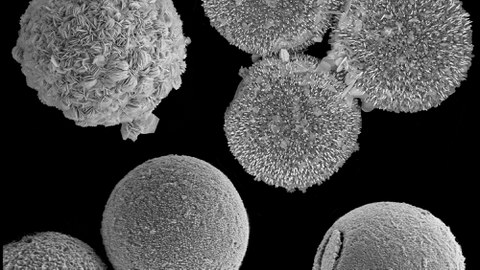Mar 13, 2023
Scientists Transform Algae into Unique Functional Perovskites with Tunable Properties

Shells of L. granifera algae after chemical transformation imaged with electron microscope.
Scientists from TU Dresden transformed mineral shells of algae into functional perovskites with unique crystal structures and controllable electro-optical properties.
Scientists have transformed single-cell algae into functional perovskite materials. The team led by scientists at the B CUBE – Center for Molecular Bioengineering at TU Dresden converted mineral shells of algae into lead halide perovskites with tunable physical properties. The new perovskites have unique nano-architectures unachievable by conventional synthetic production. The method can be applied to the mass production of perovskites with tunable structural and electro-optical properties from single-celled organisms. The results were published in the journal Advanced Science.
Perovskites are materials that are increasingly popular for a wide range of applications because of their remarkable electrical, optical, and photonic properties. Perovskite materials have the potential to revolutionize the fields of solar energy, sensing and detecting, photocatalysis, lasers, and others.
The properties of perovskites can be tuned for specific applications by changing their chemical composition and internal architecture, including the distribution and orientation of its crystal structure. At the moment, the ability to influence these properties is massively limited by manufacturing methods. A team of scientists at TU Dresden was able to create perovskites with unique nano-architectures and crystal properties from algae, taking advantage of years of evolution of these single-celled organisms.
Taking Advantage of the Evolution
“Unicellular organisms have responded over hundreds of millions of years to a wide range of environmental factors such as temperature, pH, and mechanical stress. As a result, some of them evolved to produce absolutely unique biomaterials that are exclusive to nature,” says Dr. Igor Zlotnikov, research group leader at the B CUBE – Center for Molecular Bioengineering who led the study. “Minerals formed by living organisms often exhibit structural and crystallographic characteristics that are far beyond the production capacities offered by current synthetic methods.”
The team focused on L. granifera, a type of algae that uses calcite to form shells. Their spherical shells have a unique crystal architecture. The crystals are aligned radially which means that they spread out from the center of the sphere outwards. “The current manufacturing methods of perovskites are not able to produce materials like this synthetically. We can however try to transform the existing natural structures into functional materials while keeping their original architecture” adds Dr. Zlotnikov.
Chemical Tuning
To transform the natural mineral shells of algae into functional perovskites, the team had to substitute chemical elements in calcite. To do that, they adapted a method developed by their collaborators at AMOLF institute in Amsterdam. During the transformation, scientists were able to produce different types of crystal architectures by altering the chemical makeup of the material. In that way, they could fine-tune their electro-optical properties.
By converting the calcite shells to lead halides with either iodine, bromide, or chloride, the team could create functional perovskites that are optimized to emit only red, green, or blue light.
Ready for Scaling Up
“We show that minerals produced by single-cell organisms can be transformed into technologically relevant functional materials. Instead of competing with nature, we can take advantage of the years of evolutionary adaptation they already went through” says Dr. Zlotnikov.
The method developed by his team can be scaled up, opening up the possibility for the industry to take advantage of algae and numerous other calcite-forming single-celled organisms to produce functional materials with unique shapes and crystallographic properties.
Funding
The project was part of the DinoLight imitative supported by the Free State of Saxony to develop innovative, environmentally friendly materials and technologies based on naturally occurring three-dimensional nanostructures.
Original Publication
Lucas Kuhrts, Lukas Helmbrecht, Willem L. Noorduin, Darius Pohl, Xiaoxiao Sun, Alexander Palatnik, Cornelia Wetzker, Anne Jantschke, Michael Schlierf, and Igor Zlotnikov: Recruiting Unicellular Algae for the Mass Production of Nanostructured Perovskites. Advanced Science (February 2022)
Link: https://doi.org/10.1002/advs.202300355
About B CUBE
B CUBE – Center for Molecular Bioengineering was founded as a Center for Innovation Competence within the initiative “Unternehmen Region” of the German Federal Ministry of Education and Research. It is part of the Center for Molecular and Cellular Bioengineering (CMCB). B CUBE research focuses on the investigation of living structures on a molecular level, translating the ensuing knowledge into innovative methods, materials and technologies.
Web: www.tu-dresden.de/cmcb/bcube
Resources:
Website of the research group of Dr. Igor Zlotnikov: https://tud.link/xnfz
High-resolution photos: https://tud.link/79l6
Scientific Contact:
Dr. Igor Zlotnikov
Tel: +49 351 463-43090
E-mail:
